Charging Load Allocation Strategy of EV Charging Station Considering Charging Mode
Abstract
:1. Introduction
2. Analysis of EV Owners’ Charging Behavior
3. Determination of Charging Strategy for Charging Station
3.1. Research on Charging Price of EVs
3.2. EV Charging Mode
4. Model Optimization
5. Case Analysis
5.1. Hypotheses of Simulation
5.2. Simulation Results
5.2.1. Coordinated Charging and Disordered Charging
5.2.2. Different Charging Modes in Disordered Charging
5.2.3. Different Charging Modes in Coordinated Charging
5.2.4. Coordinated Charging Analysis under Different EV Controllable Ratios
6. Conclusions
Author Contributions
Funding
Conflicts of Interest
References
- Clairand, J.M.; Javier, R.G.; Bel, C.A. Smart Charging for Electric Vehicle Aggregators considering Users’ Preferences. IEEE Access 2018, 6, 54624–54635. [Google Scholar] [CrossRef]
- Gan, L.; Ufuk, T.; Steven, H.L. Optimal Decentralized Protocol for Electric Vehicle Charging. IEEE Trans. Power Syst. 2013, 28, 940–951. [Google Scholar] [CrossRef]
- Yao, W.; Zhao, J.; Wen, F. A Hierarchical Decomposition Approach for Coordinated Dispatch of Plug-in Electric Vehicles. IEEE Trans. Power Syst. 2013, 28, 2768–2778. [Google Scholar] [CrossRef]
- Richardson, P.; Flynn, D.; Keane, A. Optimal Charging of Electric Vehicles in Low-Voltage Distribution Systems. IEEE Trans. Power Syst. 2012, 27, 268–279. [Google Scholar] [CrossRef]
- Rashidizadeh-Kermani, H.; Vahedipour-Dahraie, M.; Najafi, H.R.; Anvari-Moghaddam, A.; Guerrero, J.M. A Stochastic Bi-Level Scheduling Approach for the Participation of EV Aggregators in Competitive Electricity Markets. Appl. Sci. 2017, 7, 1100. [Google Scholar] [CrossRef]
- Wang, B.; Ai, X. Coordinated Charging of Peak-valley Time-period Optimization by Considering V2G User Reactivity. Mod. Electr. Power 2016, 33, 39–44. [Google Scholar]
- Chokkalingam, B.; Padmanaban, S.; Siano, P.; Krishnamoorthy, R.; Selvaraj, R. Real-Time Forecasting of EV Charging Station Scheduling for Smart Energy Systems. Energies 2017, 10, 377. [Google Scholar] [CrossRef]
- Tang, D.; Peng, W. Nodal Impact Assessment and Alleviation of Moving Electric Vehicle Loads: From Traffic Flow to Power Flow. IEEE Trans. Power Syst. 2016, 31, 4231–4242. [Google Scholar] [CrossRef]
- Mao, T.; Zhang, X.; Zhou, B. Intelligent Energy Management Algorithms for EV-charging Scheduling with Consideration of Multiple EV Charging Modes. Energies 2019, 12, 265. [Google Scholar] [CrossRef]
- Sun, B.; Huang, Z.; Tan, X. Optimal Scheduling for Electric Vehicle Charging with Discrete Charging Levels in Distribution Grid. IEEE Trans. Smart Grid 2018, 9, 624–634. [Google Scholar] [CrossRef]
- Erdinc, O.; Uzunoglu, M. Optimum design of hybrid renewable energy systems: Overview of different approaches. Renew. Sustain. Energy Rev. 2012, 16, 1412–1425. [Google Scholar] [CrossRef]
- Xiao, X.; Wen, J.; Tao, S. Study and Recommendations of the Key Issues in Planning of Electric Vehicles’ Charging Facilities. Trans. China Electrotech. Soc. 2014, 29, 1–10. [Google Scholar]
- Sarker, M.; Kirschen, D. Optimal coordination and scheduling of demand response via monetary incentives. IEEE Trans. Power Syst. 2015, 6, 1341–1351. [Google Scholar] [CrossRef]
- Luo, C.; Huang, Y.; Gupta, V. Stochastic Dynamic Pricing for EV Charging Stations with Renewables Integration and Energy Storage. IEEE Trans. Smart Grid 2018, 9, 91494–91505. [Google Scholar] [CrossRef]
- Liu, P.; Yu, J.; Mohammed, E. Decentralised PEV charging coordination to absorb surplus wind energy via stochastically staggered dual-tariff schemes considering feeder-level regulations. IET Gener. Transm. Distrib. 2018, 12, 3655–3665. [Google Scholar] [CrossRef]
- Zethmayr, J.; Kolata, D. Charge for Less: An Analysis of Hourly Electricity Pricing for Electric Vehicles. World Electr. Veh. J. 2019, 10, 6. [Google Scholar] [CrossRef]
- Luo, Z.; Hu, Z.; Song, Y.; Xu, Z. Coordinated Charging and Discharging of Large-scale Plug-in Electric Vehicles with Cost and Capacity Benefit Analysis. Autom. Electr. Power Syst. 2012, 36, 19–26. [Google Scholar]
- Federal Highway Administration. US Department of Transportation. 2009 National Household Travel Survey [EB/OL]. Available online: http://nhts.ornl.gov (accessed on 30 April 2019).
- Dang, J.; Tang, Y.; Ning, J.; Fu, X.; Wang, B. A Strategy for Distribution of Electric Vehicles Charging Load Based on User Intention and Trip Rule. Power Syst. Prot. Control 2015, 16, 8–15. [Google Scholar]
- Zhang, W.; Zhang, D.; Wen, J.; Zhang, C. Optimized Design of Electric Bus Battery Swap Station. J. Beijing Jiaotong Univ. 2012, 36, 100–104. [Google Scholar]
- Xu, Z.; Hu, Z.; Song, Y. Coordinated Charging of Plug-in Electric Vehicles in Charging Stations. Autom. Electr. Power Syst. 2012, 36, 38–43. [Google Scholar]
- Luo, Q. Studies on the Impacts of Electric Vehicles Charging to the Power System and Coordinated Charging. Master’s Thesis, Zhejiang University, Zhejiang, China, 2016. [Google Scholar]

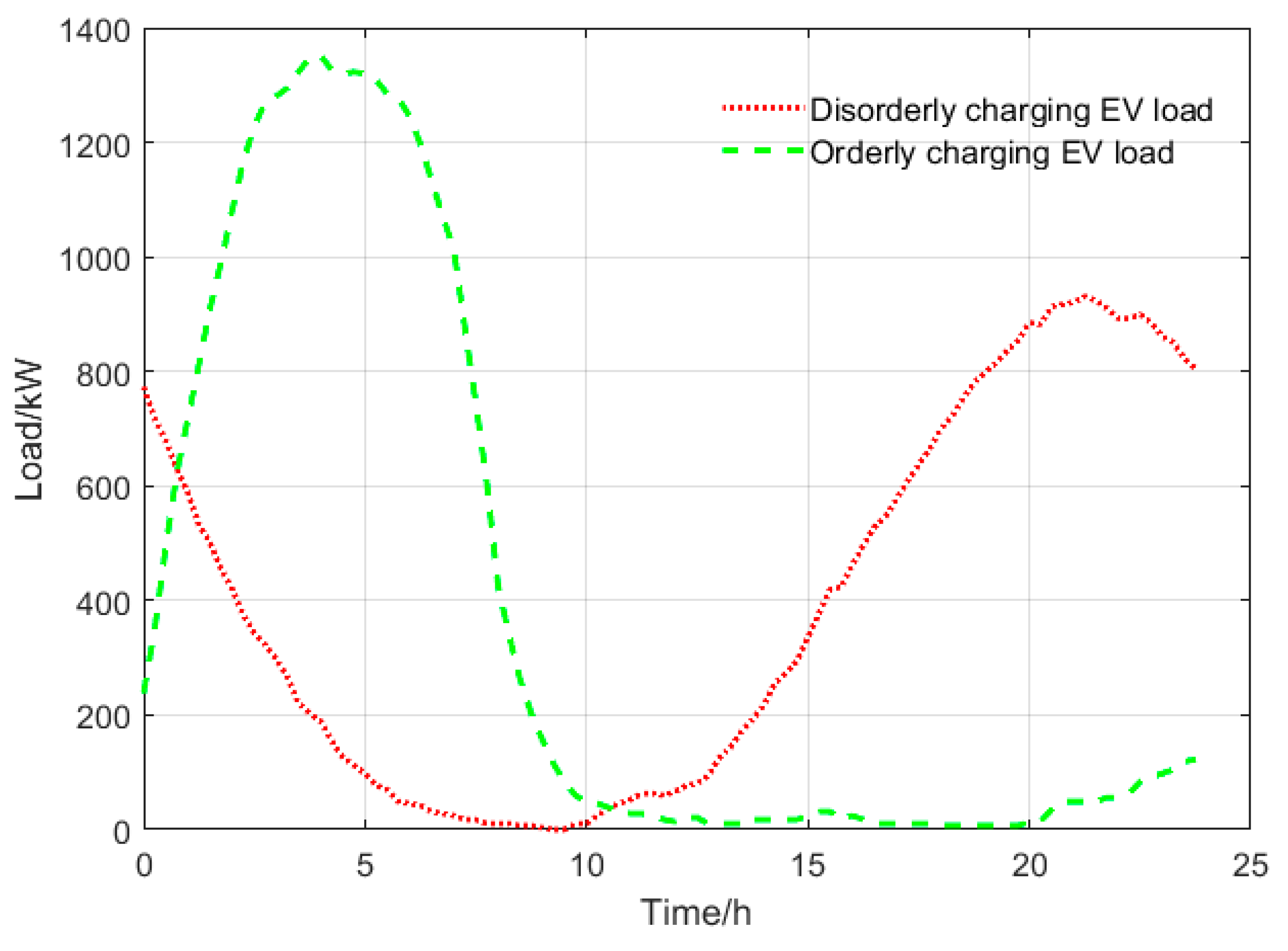
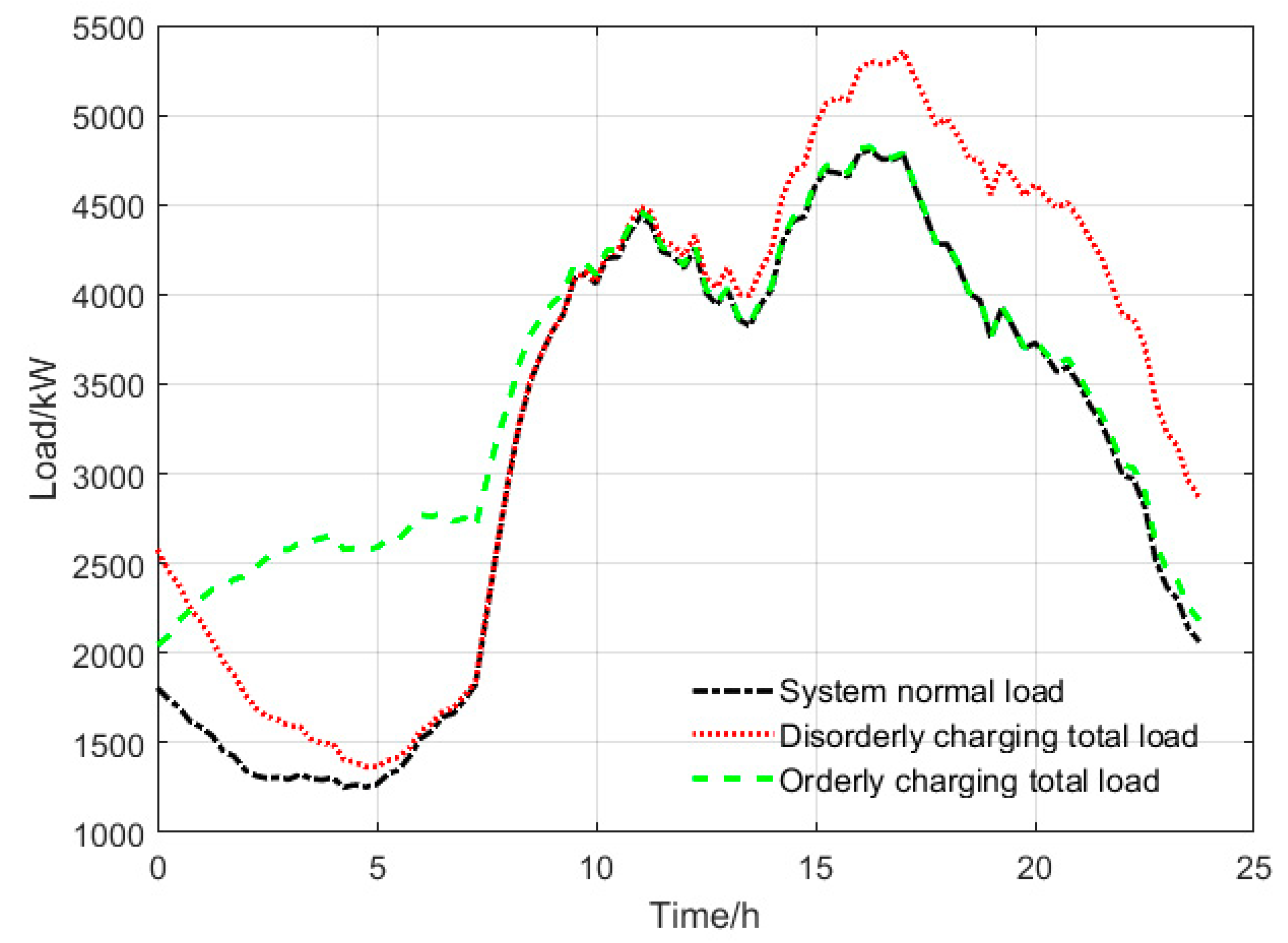
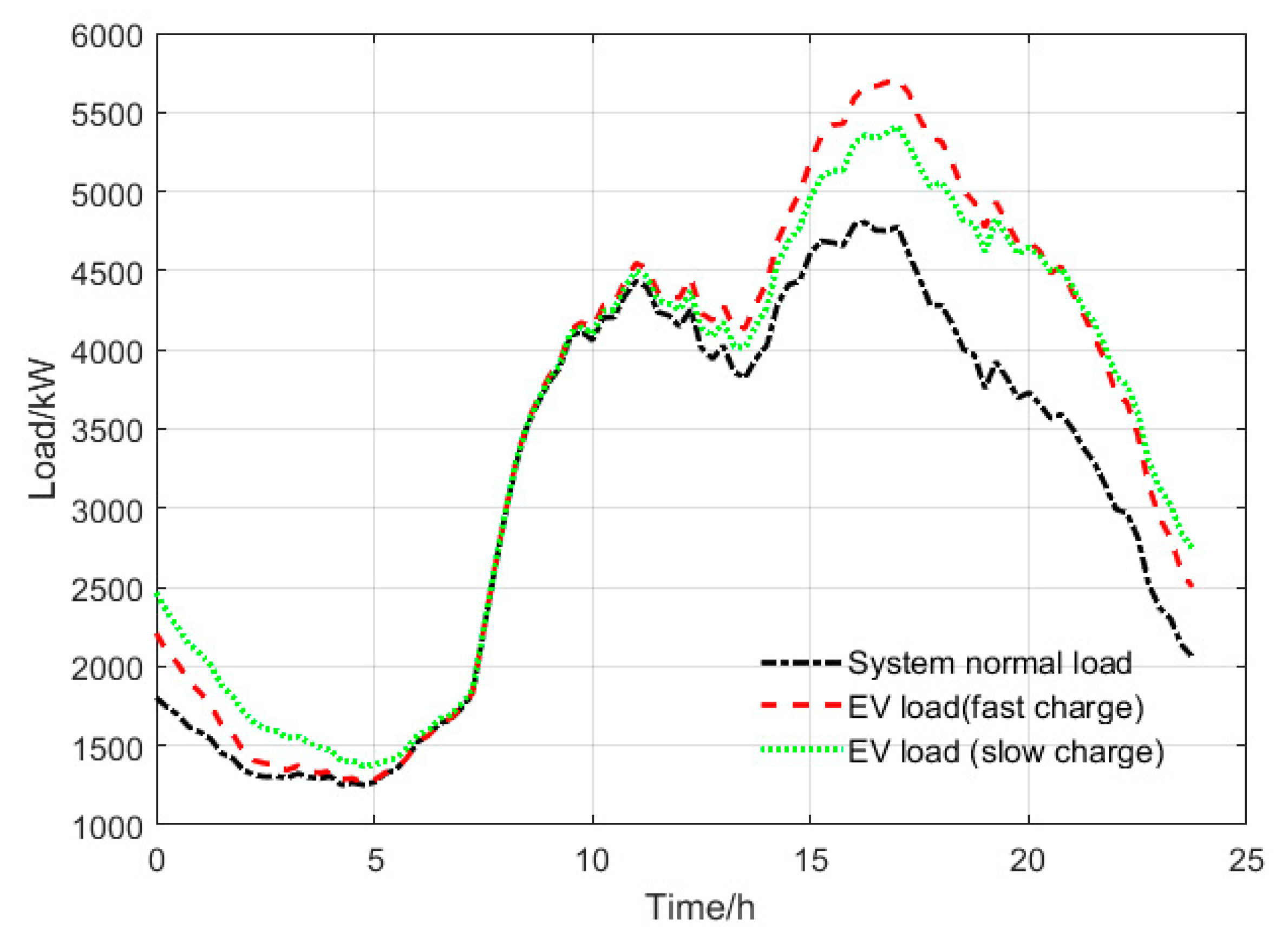
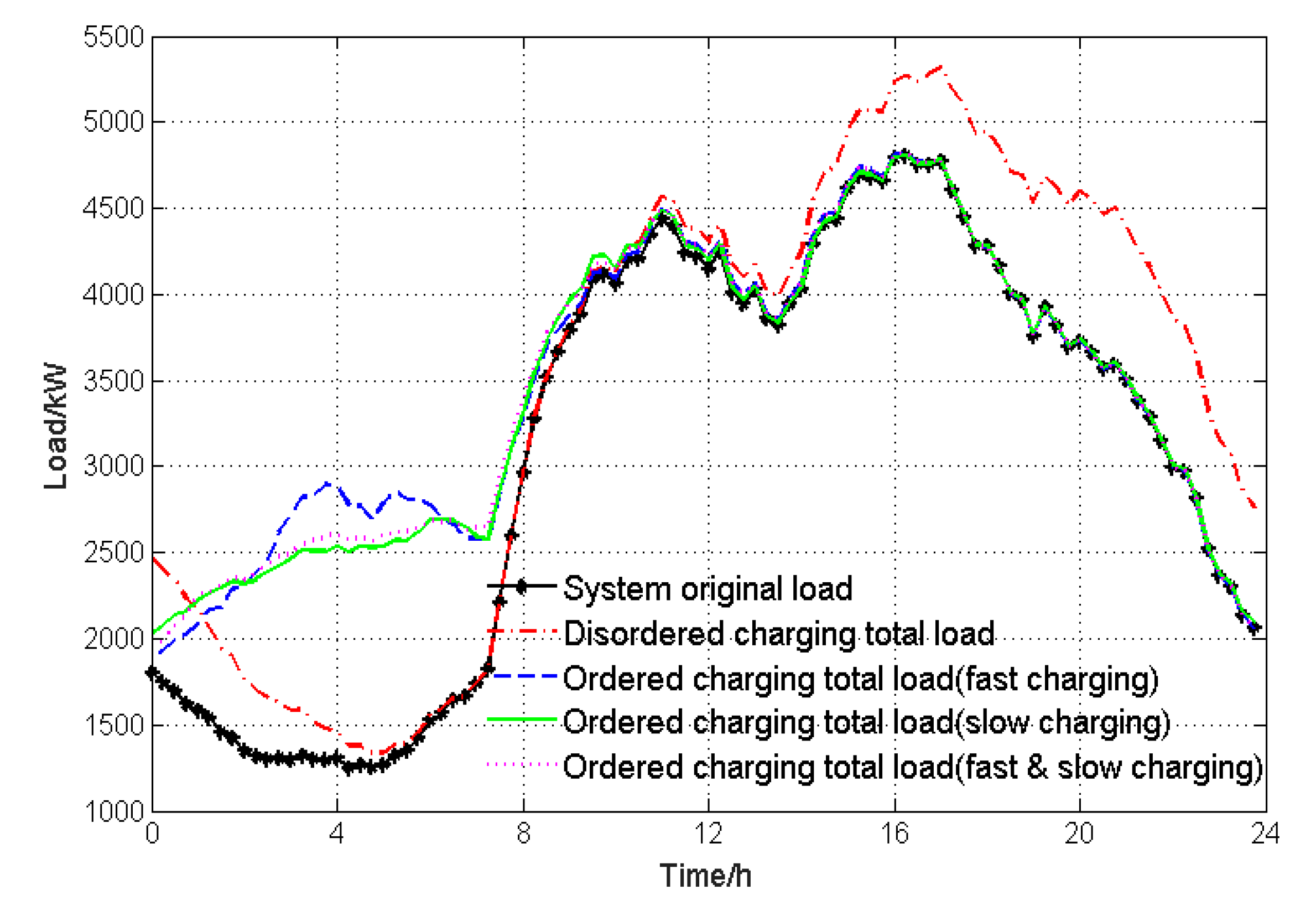
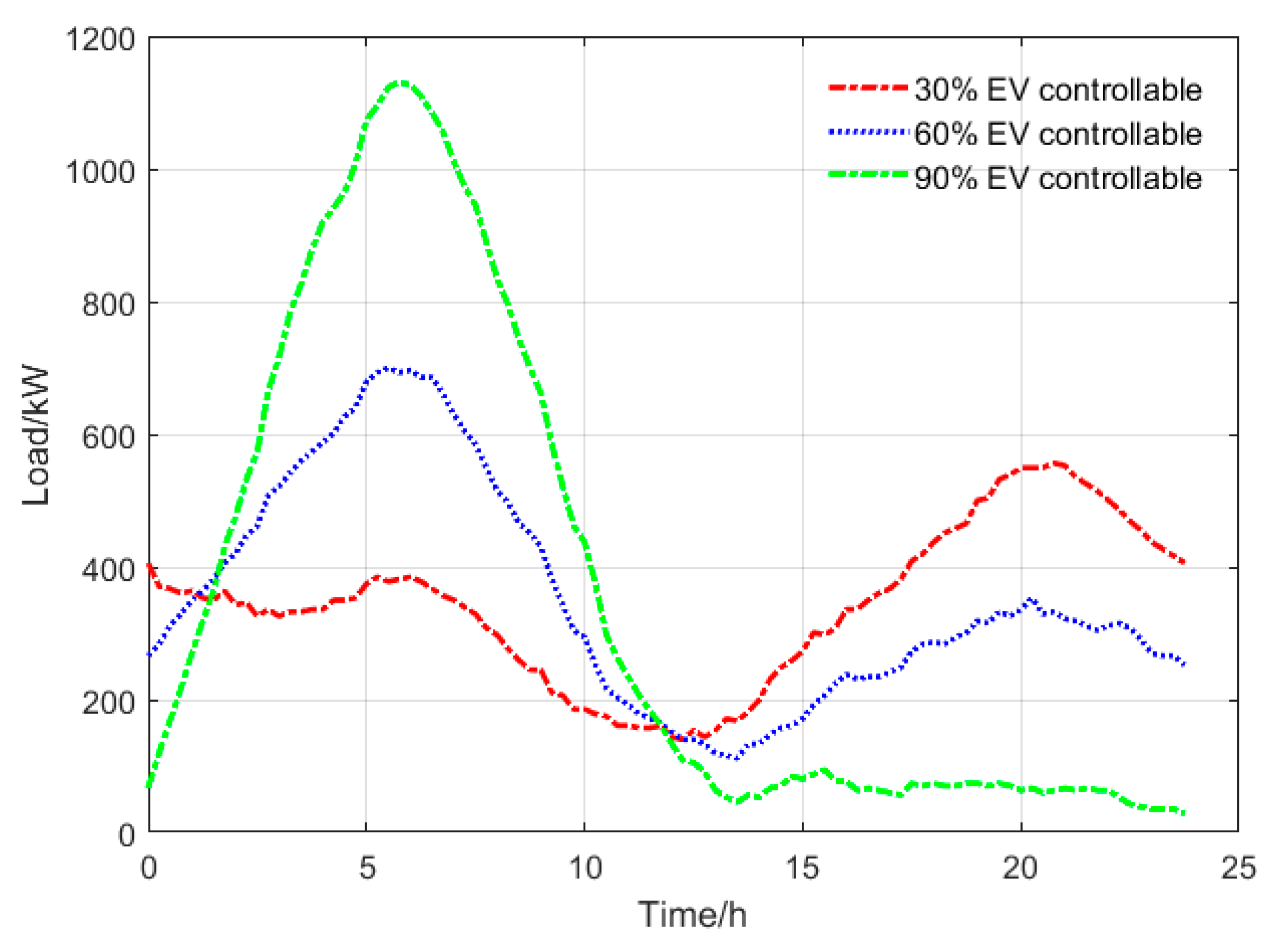
| Period of Time | Charging Station Purchase Price (USD/kWh) | Charging Station Selling Price When EV Owner Obeys the Dispatch (USD/kWh) | Charging Station Selling Price When EV Owner Disobeys the Dispatch (USD/kWh) |
|---|---|---|---|
| The peak time 8:00–12:00 17:00–21:00 | 0.126 | 0.189 | 0.251 |
| The normal times 12:00–17:00 21:00–24:00 | 0.099 | 0.149 | 0.199 |
| The valley time 0:00–8:00 | 0.053 | 0.079 | 0.106 |
| Mode | Fast Charge Scheduling Status | Slow Charge Scheduling Status |
|---|---|---|
| Fast charging but not dispatchable | Slow charging but not dispatchable | |
| Fast charging and dispatchable | Slow charging but not dispatchable | |
| Fast charging and dispatchable | Slow charging and dispatchable |
| Optimization Method | System Load Peak-To-Valley Difference (kW) | Charging Rates (USD) | Charging Station Revenue (USD) |
|---|---|---|---|
| Disordered charging | 4045 | 1227 | 409 |
| Coordinated charging (fast charge & slow charge) | 2842 | 770 | 257 |
| Coordinated charging (fast charge) | 2908 | 752 | 247 |
| Coordinated charging (slow charge) | 2828 | 754 | 251 |
| EV Charging Controllable Ration (%) | System Load Peak-To-Valley Difference (kW) | EV Charging Rates Regardless of Scheduling Fee (USD) | Charging Station Revenue Regardless of Scheduling Fee (USD) | EV Charging Rates Considering Scheduling Fee (USD) | Charging Station Revenue Considering Scheduling Fee (USD) | Proportion of Revenue Increase Considering the Scheduling Fee (%) |
|---|---|---|---|---|---|---|
| 30% | 3483 | 1139 | 370 | 1387 | 647 | 74.7 |
| 60% | 3190 | 1025 | 342 | 1185 | 502 | 46.8 |
| 90% | 2980 | 927 | 309 | 961 | 343 | 10.9 |
© 2019 by the authors. Licensee MDPI, Basel, Switzerland. This article is an open access article distributed under the terms and conditions of the Creative Commons Attribution (CC BY) license (http://creativecommons.org/licenses/by/4.0/).
Share and Cite
Zhao, Y.; Huang, H.; Chen, X.; Zhang, B.; Zhang, Y.; Jin, Y.; Zhang, Q.; Cheng, L.; Chen, Y. Charging Load Allocation Strategy of EV Charging Station Considering Charging Mode. World Electr. Veh. J. 2019, 10, 47. https://doi.org/10.3390/wevj10020047
Zhao Y, Huang H, Chen X, Zhang B, Zhang Y, Jin Y, Zhang Q, Cheng L, Chen Y. Charging Load Allocation Strategy of EV Charging Station Considering Charging Mode. World Electric Vehicle Journal. 2019; 10(2):47. https://doi.org/10.3390/wevj10020047
Chicago/Turabian StyleZhao, Yutong, Hong Huang, Xi Chen, Baoqun Zhang, Yiguo Zhang, Yuan Jin, Qian Zhang, Lin Cheng, and Yanxia Chen. 2019. "Charging Load Allocation Strategy of EV Charging Station Considering Charging Mode" World Electric Vehicle Journal 10, no. 2: 47. https://doi.org/10.3390/wevj10020047
APA StyleZhao, Y., Huang, H., Chen, X., Zhang, B., Zhang, Y., Jin, Y., Zhang, Q., Cheng, L., & Chen, Y. (2019). Charging Load Allocation Strategy of EV Charging Station Considering Charging Mode. World Electric Vehicle Journal, 10(2), 47. https://doi.org/10.3390/wevj10020047





